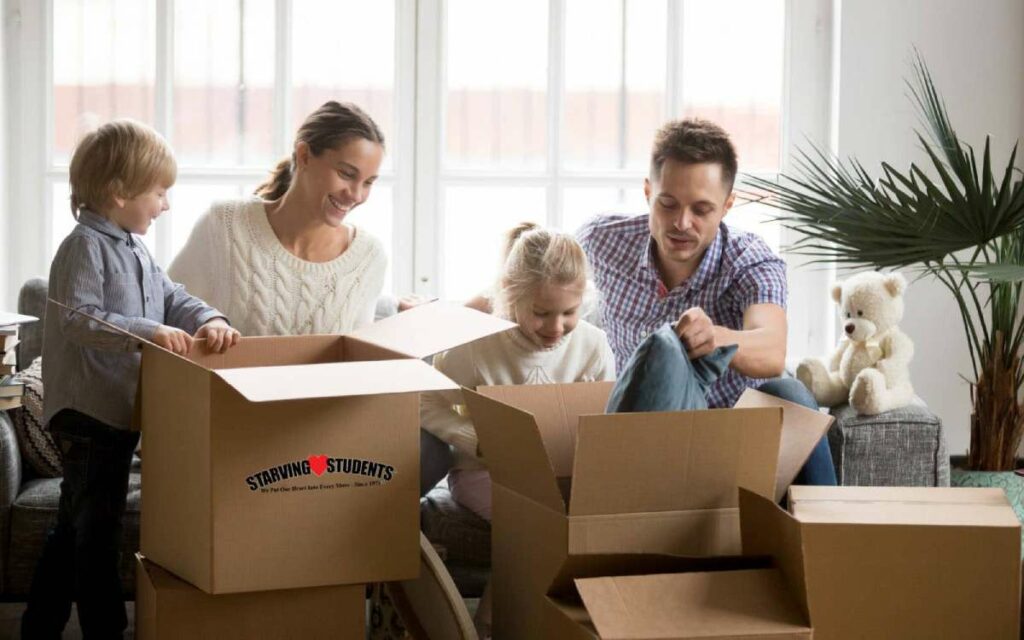
When you’re preparing to move with kids, it’s essential to consider how the transition can impact them emotionally and socially.
You might think involving them in the process could ease some of their apprehension, but there are specific strategies that can make a significant difference.
Maintaining familiar routines during this time can provide the stability they need, while a thoughtful welcome plan can help them feel at home in the new environment.
Understanding these elements is crucial, and you’ll want to explore the details that can truly make this experience smoother for everyone involved.
Involve Kids in the Process
Involving children in the moving process can significantly reduce their anxiety and help them adapt more smoothly to their new home.
Open Communication and Explanation:
- Discuss the move early on: Talk to your children about the move well in advance, explaining the reasons for the move in an age-appropriate manner.
- Address their concerns: Address any concerns or fears they may have about the move, such as leaving friends, changing schools, or adjusting to a new environment.
- Answer their questions honestly and patiently: Encourage them to ask questions and answer them openly and honestly.
Encourage Participation:
- Involve them in packing: Allow your children to participate in packing their own belongings, giving them a sense of control and ownership.
- Let them make choices: Let them choose which toys to keep and which to donate, and involve them in decluttering their own belongings.
- Decorate their new room: Involve them in decorating their new room by allowing them to choose paint colors, furniture, or other decorative items. This helps them feel more invested in their new space.
Explore the New Neighborhood:
- Visit the new area: Take your children on visits to the new neighborhood, exploring parks, schools, and local shops.
- Meet new neighbors: Introduce them to potential new friends and neighbors in the new community.
Foster a Sense of Excitement:
- Highlight the positive aspects: Emphasize the exciting aspects of the move, such as making new friends, exploring new places, and embarking on new adventures.
- Create a sense of anticipation: Build excitement about the move by sharing stories and pictures of the new home and neighborhood.
By actively involving your children in the moving process, you can help them feel more in control, reduce their anxiety, and embrace this new chapter in their lives with excitement and enthusiasm.
Maintain Familiar Routines
Maintaining familiar routines is crucial for children’s well-being during a move. It provides a sense of stability and predictability in an otherwise chaotic time.
Prioritize Consistency:
- Mealtimes: Stick to regular mealtimes as closely as possible, even if it means adjusting slightly to accommodate the moving process.
- Bedtime Routines: Maintain consistent bedtime routines, including bath time, story time, and a quiet bedtime environment.
- Daily Activities: Continue with regular activities like playtime, reading, and outdoor activities, even if they need to be adapted slightly.
Involve Children in Routines:
- Shared Responsibilities: Involve children in maintaining routines, such as setting the table, helping with meal preparation, or choosing a bedtime story.
- Family Time: Schedule dedicated family time for activities like board games, movie nights, or reading together.
Flexibility and Communication:
- Be Flexible: Be prepared to be flexible with routines if necessary.
- Open Communication: Communicate any changes to the routine with your children in a clear and age-appropriate manner.
- Acknowledge and Address Concerns: Acknowledge and address any concerns your children may have about changes to their routine.
By maintaining familiar routines and providing a sense of predictability, you can help your children navigate the challenges of moving and feel more secure and comfortable in their new home.
Create a Welcome Plan
A thoughtful welcome plan can make a significant difference in how smoothly your children adjust to their new home.
Community Welcome:
- Host a Welcome Gathering: Organize a small welcome gathering for your child, inviting neighbors and other children in the area.
- Foster Community Connections: This helps your child meet new friends and feel a sense of belonging in their new community from the start.
Personalized Welcome Kit:
- Create a Special Kit: Assemble a personalized welcome kit for your child.
- Include Local Exploration Items: Include a map of the neighborhood, a list of local parks and playgrounds, information about local libraries and museums, and some fun local snacks.
Decorating Their New Room:
- Involve Children in Decorating: Involve your children in decorating their new room.
- Personalize Their Space: Allow them to choose paint colors, furniture, and other decorative items to make the space feel uniquely their own.
Explore the New Area:
- Plan Family Outings: Plan family outings to explore local parks, museums, and other attractions.
- Embrace Local Events: Attend local events and festivals to encourage your child to embrace their new community.
By creating a welcoming and supportive environment, you can help your children feel excited about their new home and make the transition a positive and memorable experience.
Moving with children requires careful planning and a focus on their emotional well-being.
By involving them in the process, maintaining familiar routines, and creating a warm and welcoming environment in their new home, you can help them navigate this transition with greater ease. By addressing their concerns, providing a sense of security, and fostering a sense of belonging in their new community, you can ensure a smoother and more positive moving experience for the entire family.
Starving Movers